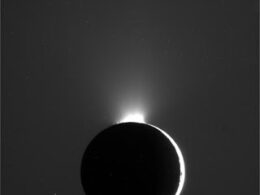Home / Space news /
Mars meteorites held liquid water
By Paul Sutherland on February 2, 2011 4:44 pm / no comments
Space scientists have found evidence of liquid water on Mars caused by a giant asteroid impact. Clues to the cosmic collision were discovered in rare martian meteorites that crashed to Earth.
They are named nakhlites after the Egyptian village of El-Nakhla where a shower of stones fell a century ago. The bombardment came from a rock that was itself blasted out of the Red Planet by an impact millions of ago and disintegrated as it plunged through our atmosphere.
NASA scientists have previously claimed to have found fossilised martian bacteria in one of the Egyptian meteorites in London. Fragments of that fall in 1911, which locals claimed killed a dog, were brought to the UK and lodged in the Natural History Museum.
Space scientists at Leicester University, England, examined samples from five nakhlites. Their detective work revealed veins inside that were caused by an asteroid strike which left a crater up to 10km wide on Mars.
Deposits of minerals and a gel within the veins showed that the impact caused buried ice on Mars to melt and flow into the rock.
Hitesh Changela and Dr John Bridges, of Leicester’s Space Research Centre, used powerful electron microscopes to make their discovery, published in the journal Meteoritics and Planetary Science.
Dr Bridges said: “We are now starting to build a realistic model for how water-deposited minerals formed on Mars, showing that impact heating was an important process. With models like this we will better understand the areas where we think that water was once present on Mars.”
The Nakhla meteorite in London hit the headlines in 2009 when some NASA scientists claimed to have photographed Martian organisms inside it. They were looking for evidence to support earlier claims to have found martian organisms in a meteorite picked up in Antarctica.
They, too, used an electron microscope to take a close-up picture of a slice from the meteorite, and said the bumpy surface resembled a fossilised colony of microbacteria. They added that some of the bumps resembled individual microbes and others were partly embedded in the rock’s underlying structure. Another part of the meteorite showed pits which the NASA team suggested were etched out of the rock by the organisms.
• Discover space for yourself and do fun science with a telescope. Here is Skymania’s advice on how to choose a telescope. We also have a guide to the different types of telescope available. Check out our monthly sky guide too!
©PAUL SUTHERLAND, Skymania.com
Please click here to get FREE email alerts of our latest space stories!
« Fast-living star creates shockwaves | Six worlds found in new solar system »


